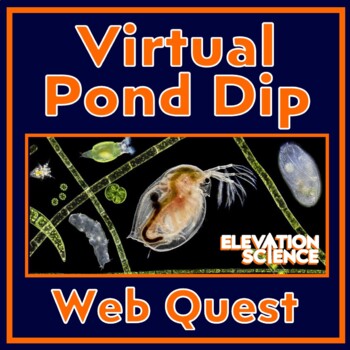Virtual Pond Dip Microscopic Protists and Animals Activity Webquest
Elevation Science
639 Followers
Grade Levels
7th - 10th
Subjects
Resource Type
Standards
CCSSRST.6-8.4
CCSSRST.9-10.4
NGSSMS-LS1-2
NGSSMS-LS2-2
NGSSMS-LS2-3
Formats Included
- PDF
- Google Apps™
- Webquests
Pages
4 pages
Elevation Science
639 Followers

Includes Google Apps™
The Teacher-Author indicated this resource includes assets from Google Workspace (e.g. docs, slides, etc.).
What educators are saying
This was a perfect activity to complete before looking at pond water in the microscopes. Once you explain to students how to use the website (not difficult) and how the factual information is laid out, students were able to independently complete the assignment.
I used this as an extra credit opportunity as we do not have classroom computers. The kids who completed this activity enjoyed it.
Description
GOOGLE DOCS and PRINT VERSION INCLUDED! Reinforce simple classification, teach about life in a drop of pond water, and take students on a virtual journey through a microscopic world!
This webquest was created to prepare students for a lab on microscopic pond organisms. However, it can just as well be used as a stand-alone assignment.
In this activity, students will:
- Learn about animal-like protozoans, plant-like algae, and protists with both characteristics.
- Learn about common microscopic animals found in pond water such as cnidarians, rotifers, nematodes, and crustaceans.
- Answer questions based on website information.
- Draw organisms.
Teacher Notes:
- Answer key included.
- Please note that this resource is not editable.
- A link to the Google Docs version is provided in the downloadable PDF.
Please consider clicking HERE to follow Elevation Science on TPT!
Total Pages
4 pages
Answer Key
Included
Teaching Duration
N/A
Report this resource to TPT
Reported resources will be reviewed by our team. Report this resource to let us know if this resource violates TPT’s content guidelines.
Standards
to see state-specific standards (only available in the US).
CCSSRST.6-8.4
Determine the meaning of symbols, key terms, and other domain-specific words and phrases as they are used in a specific scientific or technical context relevant to grades 6–8 texts and topics.
CCSSRST.9-10.4
Determine the meaning of symbols, key terms, and other domain-specific words and phrases as they are used in a specific scientific or technical context relevant to grades 9–10 texts and topics.
NGSSMS-LS1-2
Develop and use a model to describe the function of a cell as a whole and ways the parts of cells contribute to the function. Emphasis is on the cell functioning as a whole system and the primary role of identified parts of the cell, specifically the nucleus, chloroplasts, mitochondria, cell membrane, and cell wall. Assessment of organelle structure/function relationships is limited to the cell wall and cell membrane. Assessment of the function of the other organelles is limited to their relationship to the whole cell. Assessment does not include the biochemical function of cells or cell parts.
NGSSMS-LS2-2
Construct an explanation that predicts patterns of interactions among organisms across multiple ecosystems. Emphasis is on predicting consistent patterns of interactions in different ecosystems in terms of the relationships among and between organisms and abiotic components of ecosystems. Examples of types of interactions could include competitive, predatory, and mutually beneficial.
NGSSMS-LS2-3
Develop a model to describe the cycling of matter and flow of energy among living and nonliving parts of an ecosystem. Emphasis is on describing the conservation of matter and flow of energy into and out of various ecosystems, and on defining the boundaries of the system. Assessment does not include the use of chemical reactions to describe the processes.





